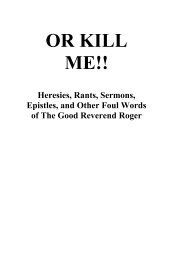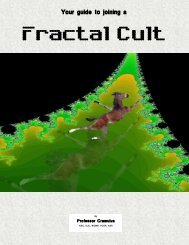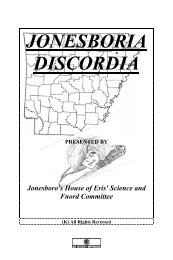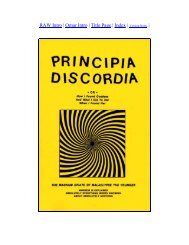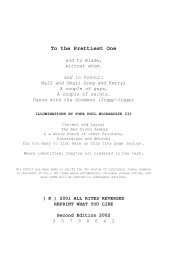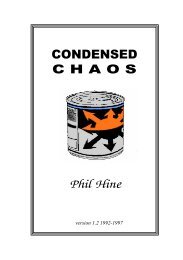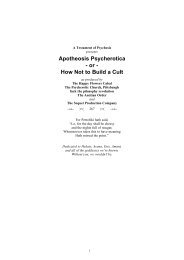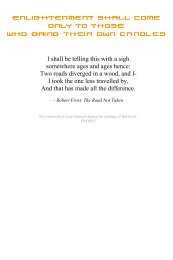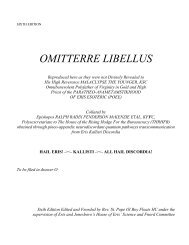Coincidance - Principia Discordia
Coincidance - Principia Discordia
Coincidance - Principia Discordia
You also want an ePaper? Increase the reach of your titles
YUMPU automatically turns print PDFs into web optimized ePapers that Google loves.
112 COINCIDANCE<br />
Violet's garden has in it a statue of a winged skeleton, and this comes<br />
between her and Dr. Sugar at a significant moment.<br />
Finally, the place where Sebastian is killed is "the ruins of an old temple,"<br />
that looked "horrible ... as if it had been the scene of terrible sacrificial rites."<br />
Sebastian is, indeed, a sacrificial victim, and the winged skeleton reappears<br />
briefly in a surrealistic half-image on the screen just before the murder is<br />
consummated. Sebastian, actually, is a self-elected sacrifice, like Christ,<br />
testifying to a very non-Christian vision of God.<br />
That Sebastian had had a "vision of God" we learn very early in the story.<br />
Violet tells us about it, in the longest and most poetic speech Tennessee<br />
Williams has ever written. Sebastian saw God in the Galapagos Islands at<br />
the breeding-time of the turtles.<br />
Every year at this time the female turtles crawl out of the sea, laboriously<br />
lay their eggs, and, hideously tired, crawl weakly back into the sea. In a while<br />
the eggs hatch and the young come out and begin their run toward the sea.<br />
But the great birds of the Galapagos know all about the breeding-time of<br />
the turtles and they wait for this moment every year. As the young turtles<br />
race toward the sea, the birds descend from the sky, thousands of them, in a<br />
great black cloud. They attack the infant turtles, turn them over, tear their<br />
bellies and devour them.<br />
Of the hundreds of turtles that hatch each year, only about one-tenth of<br />
one percent ever reach the sea. The rest are eaten.<br />
When Sebastian saw this natural process he knew in a poetic flash that<br />
"God is cruel and creation and destruction are the same." The God he<br />
worshipped, the God to whom his poems are henceforth written, was the<br />
God of Melville's "shark massacre," the Hangman God of Joyce's Ulysses, the<br />
sadistic Nobodaddy of Blake's prophetic poems, the God of Greek tragedy,<br />
the God who, in King Lear, kills men for sport.<br />
That Sebastian's vision of God was a true one is the dark, hidden fear or<br />
every religious person. The non-dualistic Orient accepts such a thought<br />
with equanimity: when Ramakrishna saw the goddess Kali give birth and<br />
then devour her own child, he took the vision as a true revelation of the<br />
oneness of creation and destruction.<br />
To Buddhist Tibet, this is the unity of yah and yum; to Taoist China, the<br />
unity of yin and yang. The Occident perennially seeks to repress this thought<br />
and perennially is haunted by half-awareness of it.<br />
It is the symbolic meaning of the scar that bisects Ahab in Moby Dick, and<br />
of the half-obliterated body of "the Runner" in Faulkner's Fable. It recurs<br />
again and again in Euripedes, Sophocles, Shakespeare, Joyce and dozens of<br />
others.<br />
With this clue in mind we can see that the world of Suddenly, Last Summer



